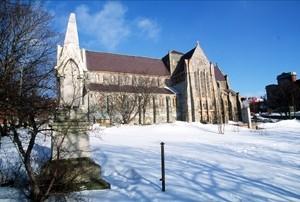St. John the Baptist Anglican Cathedral National Historic Site of Canada
St. John's, Newfoundland and Labrador

General view
© Parks Canada Agency | Agence Parcs Canada, J. Butterill, 1994.
Address :
16 Church Hill, St. John's, Newfoundland and Labrador
Recognition Statute:
Historic Sites and Monuments Act (R.S.C., 1985, c. H-4)
Designation Date:
1979-11-15
Dates:
-
1847 to 1850
(Construction)
-
1892 to 1905
(Significant)
Event, Person, Organization:
-
Edward Field
(Person)
-
George Gilbert Scott
(Architect)
-
George Gilbert Scott Jr.
(Architect)
-
Giles Gilbert Scott
(Architect)
Other Name(s):
-
St. John the Baptist Anglican Cathedral
(Designation Name)
Research Report Number:
1979-039
Plaque(s)
Existing plaque: 16 Church Hill, St. John's, Newfoundland and Labrador
Begun in 1847, under the direction of Bishop Feild, this cathedral was designed by the noted British architect George Gilbert Scott and is an internationally important monument of the Gothic Revival style. Its historical correctness and structural rationalism express the ideals of the Cambridge Camden Society, an English Group dedicated to reforming the Anglican Church through a return to 13th century sources. The internal composition of nave and aisles is clearly reflected on the exterior. Scott's cathedral burned in 1892 and was rebuilt by his son soon after. The intended tower has never been erected.
Description of Historic Place
St. John the Baptist Anglican Cathedral National Historic Site of Canada is an austerely magnificent stone cathedral built in the Gothic Revival style. It is located on a hillside overlooking the harbour of St. John’s in a mixed commercial and residential neighbourhood of late-19th-century buildings. The formal recognition consists of the building on its legal property.
Heritage Value
St. John the Baptist Anglican Cathedral was designated as a national historic site of Canada because:
— it is a nationally significant example of the Gothic Revival Style;
— its historical correctness and structural rationalism express the ideals of the Cambridge Camden Society.
Construction of the original St. John the Baptist Anglican Cathedral, for Canada’s oldest Anglican parish, began in 1847. It was built under the direction of Right Reverend Edward Field, Bishop of Newfoundland, and designed by the well-known English church architect George Gilbert Scott. The Cathedral is a faithful example of Scott’s ecclesiastical work, which conformed to the tenets of the Cambridge Camden Society. The Society was dedicated to recapturing the spirit and form of 13th-century Gothic church architecture. This was of particular significance in the British colonies, where a prescriptive approach to church design was intended to create a distinct and recognizable Anglican architectural identity consistent with the Anglican creed.
St. John the Baptist Anglican Cathedral, as designed by Scott, fully reflected the Society’s intentions and expectations. It was a correct Ecclesiological interpretation of Gothic architecture as articulated by the English architectural theorist A.W.N. Pugin. It occupied a dramatic site on the side of the hill near the harbour of St. John’s, which added to its monumentality. Constructed of Irish limestone and local sandstone, its symbolic cruciform plan, tall ceiling and interior arrangement followed Ecclesiological tradition. In 1892 the unfinished cathedral was almost completely destroyed during one of the great fires of St. John’s. Using surviving exterior walls, the architect’s son George Gilbert Scott Jr. rebuilt the cathedral according to his father’s original plans, with careful attention paid to local climatic conditions. It remains an early and fine example of the ecclesiological Gothic Revival style in North America. Its setting in a well-preserved turn-of-the-century neighbourhood strengthens the original design intentions.
Sources: Historic Sites and Monuments Board of Canada, Minutes, November 1979, February 1990.
Character-Defining Elements
Key elements contributing to the heritage value of St. John the Baptist Anglican Cathedral include:
— its siting on a hillside in downtown St. John’s;
— its large scale and cruciform plan with nave and transepts, consistent with its consecration as a cathedral;
— its interior arrangement of a nave, side aisles, transepts, and a chancel and sanctuary reflecting the ecclesiological tenets of the Cambridge Camden Society and the clear articulation of functional plan on the exterior, as seen in the crossing of the nave and transept roofs and in the clerestory’s marking of the centre aisle of the nave;
— the planar exterior massing with flat east end, simple west front, north porch and truncated tower over the crossing built as base for a planned tower;
— its rugged construction of Irish limestone and local granite with limited exterior ornamentation concentrated on the main entrance, primarily composed of dressed sandstone around openings, corners and cornices, purposely intended to reduce the Cathedral’s vulnerability to decay in the extreme weather conditions in St. John’s;
— its restrained Gothic Revival style exterior detailing, including buttressing, pointed-arch windows, round windows in the transept gables, dressed sandstone parapets, quatrefoil windows, Gothic Revival style tracery, plain rustic masonry, and the grouping of tall lancet windows above the main entrance porch;
— the austere Gothic Revival style interior detailing, including, the simple wooden rib-vaulted ceiling and vaulted aisles;
— the stained glass windows, including the single stained glass window that survived the 1892 fire;
— interior decorations and fixed furnishings, including carved pillars, baptismal font, the high altar, reredos, Bishop’s throne, and pulpit.